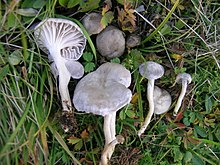Cuphophyllus atlanticus
| Felted waxcap | |
|---|---|

| |
| Cuphophyllus atlanticus, Norway | |
| Scientific classification | |
| Domain: | Eukaryota |
| Kingdom: | Fungi |
| Division: | Basidiomycota |
| Class: | Agaricomycetes |
| Order: | Agaricales |
| Family: | Hygrophoraceae |
| Genus: | Cuphophyllus |
| Species: | C. atlanticus
|
| Binomial name | |
| Cuphophyllus atlanticus J.B. Jordal & E. Larss. (2021)
| |
Cuphophyllus atlanticus is a species of agaric (gilled mushroom) in the family Hygrophoraceae. Until recently (2021), the species was considered to be conspecific with the North American Cuphophyllus canescens, but DNA sequencing has shown that it is distinct.[2] As C. canescens, it has been given the recommended English name of felted waxcap in the United Kingdom.[3] Cuphophyllus atlanticus has a European and North American distribution, occurring in Europe mainly in agriculturally unimproved grassland. Threats to its habitat have resulted in C. canescens (including C. atlanticus) being assessed as globally "vulnerable" on the IUCN Red List of Threatened Species.[1]
Taxonomy
The species was first described from Norway in 2021 as a result of
Description
Similar species
In Europe, the felted waxcap is distinguished from other grey species of Cuphophyllus by its dry, slightly felted cap that is never viscid or greasy.[4] In North America, C. canescens is very similar, but is said to have drab or brownish tints in the cap and (microscopically) smaller, more globose spores measuring 4 to 5 μm across.[2]
Distribution and habitat
In Europe, DNA studies have confirmed the presence of the felted waxcap in Norway,[2] Sweden,[2] and Scotland.[5] This is the same northerly distribution previously noted for "C. canescens" in Europe.[4] In North America, C. atlanticus has been confirmed from the United States (North Carolina) and Canada.[2]
Recent research suggests waxcaps are neither
Conservation
In Europe, Cuphophyllus atlanticus is typical of
See also
References
- ^ a b c Jordal J. "Cuphophyllus canescens. The IUCN Red List of Threatened Species". Retrieved 2022-06-02.
- ^ a b c d e f g Jordal JB, Larsson E (2021). "Cuphophyllus atlanticus (Hygrophoraceae, Agaricales) — a new sister species to the North American C. canescens". Agarica. 42: 39–48.
- ^ Holden L. "English names for fungi 2022". British Mycological Society. Retrieved 2022-06-02.
- ^ ISBN 978-87-983581-7-6.
- ^ Fortey R, Skeates S (2022). "The importance of vouchers: Cuphophyllus atlanticus in Britain". Field Mycology. 23 (1): 5–6.
- S2CID 318326.

